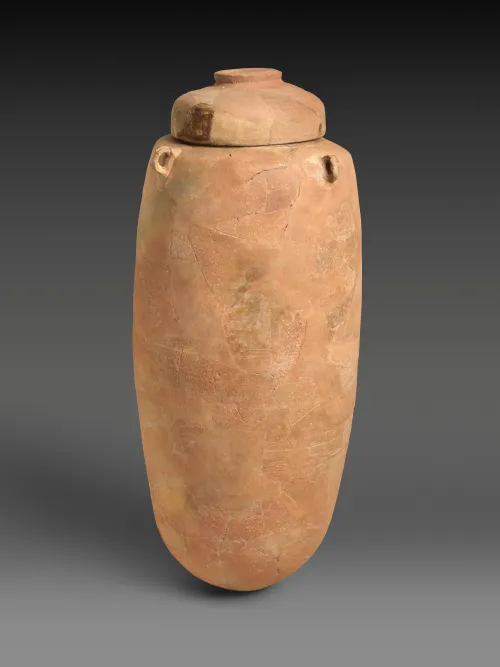Part III: The Dead Sea Scrolls
Qumran and the Essenes
Hidden in the rugged cliffs of the Judean Desert, the ruins of Qumran tell the story of an ancient Jewish sect known as the Essenes. Dissatisfied with the corruption of the priesthood in Jerusalem, this community withdrew into the wilderness around 166 BCE, establishing a monastic-like settlement. Following their leader—mysteriously referred to as the "Teacher of Righteousness"—they lived with strict discipline, practicing ritual purity and communal ownership. The Essenes devoted themselves to Scripture, meticulously copying sacred texts in their scriptorium.

Clay pot containing dead sea scrolls
As the Roman army approached in 68 CE, the Qumran inhabitants hid their precious scrolls in nearby caves, intending to retrieve them once their awaited Messianic deliverers had come. The Romans, however, destroyed the community, leaving the scrolls buried and forgotten for nearly 2,000 years.
The Archaeological Discovery of the Century
Until the mid-20th century, the oldest known Hebrew manuscripts dated back only to the 9th century CE, leaving scholars to wonder how faithfully the Old Testament had been transmitted. Then, in 1947, a Bedouin shepherd searching for a lost goat near the Dead Sea stumbled upon a cave filled with ancient scrolls stored in clay jars. Initially dismissed as forgeries, the scrolls were soon recognized as one of the most significant archaeological discoveries of all time.
Excavations uncovered 11 caves containing over 100,000 manuscript fragments, which scholars painstakingly pieced together into approximately 870 scrolls. Of these, 220 were biblical, containing portions of every Old Testament book except Esther. The remaining scrolls included religious texts, apocalyptic prophecies, and even a mysterious Copper Scroll listing hidden treasures.
Among the most remarkable finds was a complete scroll of Isaiah, preserved in pristine condition. Measuring 24 feet in length, this scroll allowed scholars to compare it with later texts. The results were astonishing: despite being copied 1,000 years earlier, it matched the Masoretic Text—the authoritative Hebrew Bible—with 99% accuracy. This confirmed the extraordinary precision of Jewish scribes in transmitting the Scriptures across centuries.

Complete scroll of Isaiah
The Significance of the Scrolls
The Dead Sea Scrolls provide irrefutable evidence of the reliability of the Hebrew Scriptures. Some textual differences did emerge, but most were minor variations in spelling or phrasing. A few, however, have influenced modern translations:
- Jacob’s Descendants: The Masoretic Text (c. 1000 CE) states that Jacob’s family numbered 70 when they entered Egypt (Exodus 1:5). However, Dead Sea Scroll 4QExod-a records the number as 75, aligning with Stephen’s speech in Acts 7:14.
- A Lost Passage: One scroll (4QSam-a) contains an additional paragraph at the end of 1 Samuel 10, referencing King Nahash of the Ammonites. This passage has since been included in some modern translations, such as the New Revised Standard Version.
Beyond textual validation, the scrolls offer a glimpse into Jewish life and thought at the time of Jesus. They demonstrate that terms like "Son of God"—used in the Gospels—were firmly rooted in Jewish tradition, countering earlier theories that they were influenced by Greco-Roman culture.
What More Might Be Discovered?
The discovery of the Dead Sea Scrolls was a groundbreaking moment in biblical scholarship, but could there be more hidden texts? Given the rugged and largely unexplored landscape of the Judean Desert, it remains possible that future excavations—or even a natural event like an earthquake—could reveal additional manuscripts. What other ancient voices might yet emerge from the sands of time, further illuminating the story of the Scriptures?
The Dead Sea Scrolls stand as a testament to the meticulous preservation of sacred texts. Thanks to the dedication of generations of scribes, the Bible we read today remains a faithful reflection of the words written thousands of years ago.
